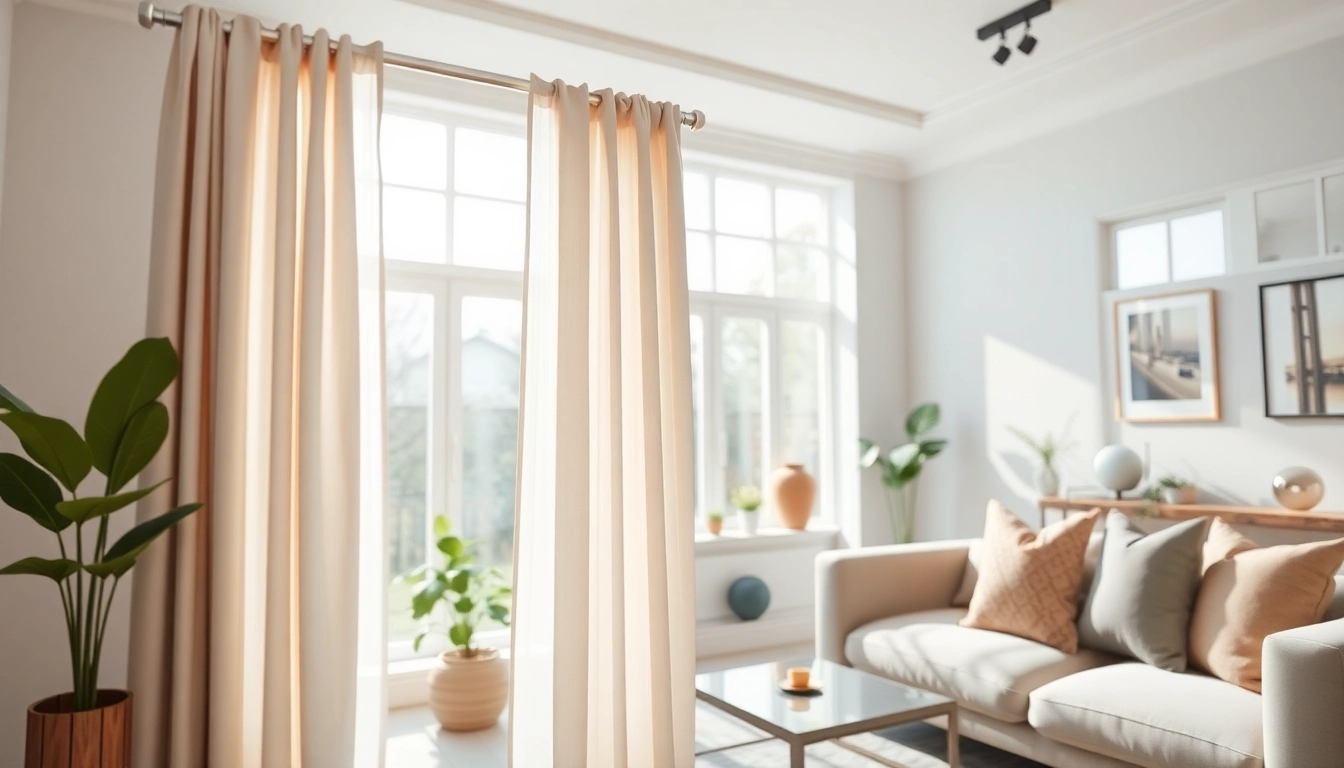Understanding Curtain Tracks and Poles
What are Curtain Tracks and Poles?
Curtain tracks and poles are essential components in the world of interior design and window treatment solutions. While both serve to hang curtains and drapes, they differ in their structure and functionality. Curtain tracks are typically made from metal or plastic and consist of a continuous runner system that allows for smooth movement of curtains along the track. They are often installed in ceilings or on walls. In contrast, poles are usually cylindrical rods, made from various materials like wood or metal, which are fixed to the wall with brackets, allowing curtains to be hung using hooks or rings. By understanding the characteristics of Curtain tracks and poles, homeowners can make informed decisions about the best option for their space.
Differences Between Curtain Tracks and Poles
One of the primary differences between curtain tracks and poles lies in their operational mechanism. Curtain tracks are designed to accommodate a gliding system, often featuring wheels or carriers that facilitate easy movement of the curtains. They are ideal for heavier drapery and larger windows as they distribute weight evenly, preventing sagging. On the other hand, poles can offer a more traditional aesthetic, allowing for a wide range of decorative finials and hardware. This option typically suits lighter fabrics better, though heavy drapes can still be used with appropriate ring systems.
Moreover, the installation process varies between the two. Curtain tracks usually require a more intricate installation process, often needing secure ceiling mounts, while poles can simply be fastened to walls with bracket sets. Additionally, tracks can be flexible or rigid, allowing for unique configurations like curved or angled windows, making them versatile for any architecture.
Benefits of Using Curtain Tracks and Poles
Both curtain tracks and poles offer significant benefits that add value and functionality to living spaces. One of the key advantages of curtain tracks is the ease of use, especially in larger windows or with heavy drapes. Their design promotes effortless movement, which is enhanced in motorized options that can open and close remotely. Curtain tracks also often reduce wear and tear on curtains due to the less abrasive nature of their movement.
On the other hand, poles present an opportunity for customization and style. The variety of finishes, colors, and decorative ends allow for more personalized design choices. Additionally, they are straightforward to install and can be a budget-friendly option depending on the selected materials. When choosing between the two, consideration should be given to the overall decor style, the weight of the curtains, and the difficulty of the installation.
Types of Curtain Tracks and Poles
Wall-Mounted Curtain Tracks and Poles
Wall-mounted options are a popular choice for those looking to maximize floor space while creating a stylish window treatment. This type of installation allows the curtains to hang close to the wall, which can make a room feel more open and airy. Wall-mounted curtain tracks are excellent for low ceilings since they don’t require any overhead installation, while poles can provide a dramatic effect as they can be mounted at varying heights to elongate window appearances.
When selecting wall-mounted systems, consider the fabric weight and how far the brackets can extend from the wall to ensure adequate support. Also, ensure that the chosen window treatment will adequately cover the desired area, as the placement of wall-mounted systems can be less forgiving than ceiling-mounted alternatives.
Ceiling-Mounted Options for Curtain Tracks and Poles
Ceiling-mounted system installations offer a sophisticated look and are ideal for large curtains or spaces requiring a clean and minimalistic design. This method keeps the apparatus hidden, allowing the fabric to appear as though it is floating. Ceiling-mounted tracks are especially effective for wide windows or room dividers and can be designed to follow curved window shapes, offering unparalleled design versatility.
Installation typically involves securing the track or pole directly to the ceiling, which may involve drilling into the ceiling material and ensuring proper anchor points for heavier fabrics. This mounting style is particularly advantageous in modern or contemporary interiors, where an unencumbered feel is desired.
Flexible vs. Rigid Curtain Tracks
When considering curtain tracks, the choice between flexible and rigid options can significantly impact both functionality and appearance. Flexible tracks are made of materials that allow them to bend and conform to various shapes, making them suitable for areas with unique architectural features or curved windows. They provide a seamless solution for hanging curtains in places where traditional systems would fail.
Conversely, rigid tracks are fixed and straight and offer sturdiness for heavy drapery installations. These tracks are typically easier to install and provide a more secure environment for curtain movement. Choosing the right type largely depends on the specific needs of the window structure and the intended visual effect.
Measuring for Curtain Tracks and Poles
How to Measure Window Size Correctly
Accurate measurements are paramount when installing curtain tracks and poles to ensure a perfect fit and desired esthetics. Start by measuring the width of the window from one end to the other. This measurement should include the overlap that curtains will cover on either side to block light and maintain privacy. Most professionals recommend adding at least six inches to each side to create a fuller appearance when the curtains are drawn open.
Next, measure the height from the top of the window frame to your desired hanging position. For a contemporary look, you might choose to hang curtains close to the ceiling, whereas traditional styling may prefer them positioned just above the window for a classic touch. Using a metal measuring tape will ensure precision, avoiding the potential for erroneous readings found in fabric or cloth measuring tools.
Considerations for Ceiling Height
Ceiling height plays a crucial role in deciding how to hang curtains. For standard ceiling heights, a simple installation might suffice; however, higher ceilings can diminish the functionality of standard pole lengths. When dealing with higher ceilings, it may be necessary to consider telescoping rods or longer tracks to maintain proportional relationships between the window and the ceiling.
Moreover, consider the overall design and finish of the curtain apparatus. Higher ceilings can accommodate grander designs, including elaborate finials, while lower ceilings may benefit from simpler, less obtrusive designs. Creating an illusion of height can also be achieved by mounting tracks higher up the wall rather than directly above the window.
Account for Hardware and Accessories
In addition to measuring the fabric and window openings, it’s essential to account for the hardware and accessories that will accompany the curtain tracks and poles. For tracks, you’ll need to ensure you include space for wall brackets or ceiling mounts. If opting for poles, consider the impact of curtain rings, hooks, and finials on the overall length of the poles and the final look.
Don’t forget to budget for appropriate supports and installation hardware, especially if you’re mounting heavy draperies. Choosing the right accessories can seamlessly integrate into your design while ensuring that the function remains intact, making curtains easier to operate and more visually appealing.
Installation Tips for Curtain Tracks and Poles
Tools Needed for Installation
Installing curtain tracks and poles may require various tools, depending on the chosen type and mounting style. Commonly required tools include a drill, various drill bits for wall/ceiling materials, a level to ensure straight installation, measuring tape, and mounting hardware (screws, anchors, etc.). A hammer and screwdriver will also be helpful for securing any brackets or anchors in place. If flexibility is desired in installation, a stud finder can also assist in locating the most secure anchoring points.
Step-by-Step Installation Process
The installation process can vary depending on whether you’re working with tracks or poles, but the following provides a general outline:
- Begin by gathering all necessary tools and materials.
- Measure window dimensions and decide on the final hanging height.
- Mark the wall or ceiling where the curtain track or pole will be installed, using a level to ensure even lines.
- Drill holes for anchors if mounting into drywall, or utilize a stud finder for screw-in places for added stability.
- Attach the brackets or mounts securely, ensuring they can support the weight of the chosen curtains.
- If installing a track, slide the carriers onto the track before securing the track to its mounts.
- Finally, hang the curtains and make any necessary adjustments.
Common Installation Mistakes to Avoid
While installing curtain tracks and poles may seem straightforward, several common pitfalls can hinder success. First, failing to accurately measure can result in improper fitting. Always double-check measurements before cutting or drilling. Secondly, neglecting to use a level can lead to a lopsided appearance, which is easily avoidable with careful attention during installation.
Further, not accounting for the weight of the curtains when selecting hardware can lead to falling or damaged apparatus. It’s crucial to consult weight recommendations provided with the hardware. Lastly, overlooking the spacing between the brackets can lead to sagging poles and poor functionality. Ensuring even spacing based on the length of the track or pole will help distribute weight evenly and prolong the overall lifespan of your window treatments.
Decorating with Curtain Tracks and Poles
Matching Curtain Styles to Track Systems
Choosing the right curtain style to pair with curtain tracks and poles is essential in achieving a cohesive look in any room. For modern spaces, lightweight, sheer fabrics work wonderfully with tracks as they can glide effortlessly and create an ethereal quality. On the other hand, heavier materials like velvet or thick drapes may necessitate a more robust pole system due to their weight.
Consider patterned curtains with bold designs to bring focus to a specific window area. If going for a minimalist look, opt for solid-colored, sleek fabrics that create a smooth finish when drawn. Ensure that the style of the curtains complements the decor theme of the room, creating harmony between the window treatment and the overall interior design.
Incorporating Curtain Tracks and Poles into Your Design
Incorporating curtain tracks and poles into interior design can dramatically influence a room’s atmosphere. One approach is to match the finish of the curtain apparatus with other metallic elements in the space, such as light fixtures or doorknobs. This attention to detail contributes to a more curated and intentional design.
For a layered look, consider using both drapes and sheers together, where the sheer fabric can be hung on tracks while heavier drapes are suspended from poles. This combination offers versatility in managing light and privacy. Additionally, the use of decorative finials on poles can serve as focal points and add interest to the overall design statement.
Maintaining and Caring for Your Curtain Tracks and Poles
Maintenance is key to ensuring the longevity of your curtain tracks and poles. Regular cleaning can keep dust and debris from building up along tracks, which can hinder movement. A simple solution is to wipe down metal or plastic tracks with a damp cloth and mild cleaner as needed. For poles, a soft cloth can preserve their finish and aesthetics while keeping them free from potential scratches or damage.
Inspecting the installation hardware regularly is essential. Check brackets and screws to ensure tightness, especially in damp environments where changes in humidity can cause materials to shift. If you notice any wear on the tracks or poles, addressing the issue sooner than later will prevent more significant problems down the line.



